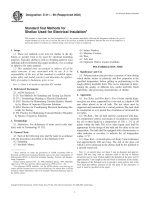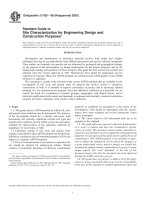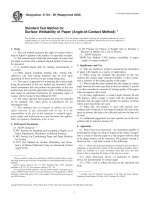Astm d 780 95 (2003)
Bạn đang xem bản rút gọn của tài liệu. Xem và tải ngay bản đầy đủ của tài liệu tại đây (28.38 KB, 2 trang )
Designation: D 780 – 95 (Reapproved 2003)
Technical Association of Pulp and
Paper Industry
Standard Method T 462 Su 72
An American National Standard
Standard Test Method for
Printing Ink Permeation of Paper (Castor Oil Test)1
This standard is issued under the fixed designation D 780; the number immediately following the designation indicates the year of
original adoption or, in the case of revision, the year of last revision. A number in parentheses indicates the year of last reapproval. A
superscript epsilon (e) indicates an editorial change since the last revision or reapproval.
for illuminating the specimen; and an adjustable mirror near
the bottom and centered on the observation hole in the top of
the box.
5.2 Separatory Funnel or Buret, with a tip of such diameter
that 25 drops of distilled water delivered at 21°C will have a
volume of 1 mL. The funnel or buret is suspended with the end
of the tip approximately 45 mm above the test specimen.
5.3 Small Bottle Cap, with black interior, having its diameter in excess of 20 mm.
5.4 Timer—Stopwatch or electric timer.
5.5 Castor Oil, USP, the temperature of which is maintained
at 23 6 1°C.
1. Scope
1.1 This test method covers the determination of the absorbancy rate of paper for printing inks having an oil vehicle but
is normally used only for easily permeable papers such as
news, book, and mimeograph.
1.2 This standard does not purport to address all of the
safety concerns, if any, associated with its use. It is the
responsibility of the user of this standard to establish appropriate safety and health practices and determine the applicability of regulatory limitations prior to use.
2. Referenced Documents
2.1 ASTM Standards: 2
D 585 Practice for Sampling and Accepting a Single Lot of
Paper, Paperboard, Fiberboard, or Related Products
D 685 Practice for Conditioning Paper and Paper Products
for Testing
NOTE 1—The viscosity of USP castor oil has been found to vary
somewhat. Accordingly, for particular tests, agreement should be reached
regarding the specific sample of oil to be used.
6. Test Specimen
6.1 Obtain a sample of the paper in accordance with
Practice D 585. From each test unit of the sample cut at least
ten square test specimens each about 50 mm on a side. Identify
five of the specimens on the wire side, and the other five on the
top side.
3. Summary of Test Method
3.1 This test method is performed by measuring the time
required for a drop of USP castor oil to produce a uniform
translucent spot on the under side of the test specimen by
permeation through the specimen.
7. Conditioning
7.1 Precondition, condition, and test the specimens in an
atmosphere in accordance with Practice D 685.
4. Significance and Use
4.1 A correlation has been established between the results of
this test and the printing of uncoated papers.
8. Procedure
8.1 Place a specimen over the hole in the top of the box.
Suspend the funnel with the end of the tip approximately 45
mm above the test specimen. Place a little castor oil in the
funnel and slowly open the cock until a drop of castor oil falls
from the funnel or buret upon the specimen. Close the cock.
Cover the oil drop with a cap having a black interior to provide
sharper determination of the end point. Observe the underside
of the paper in the mirror and measure the time interval from
the instant of contact until the spot of oil reaches a uniform and
maximum translucency. (End point appearance will differ
depending upon the amount of high refractive index pigment
present in the paper being tested.)
8.2 Make five test determinations on each side of the paper.
5. Apparatus and Materials
5.1 Viewing Box (Fig. 1), having an open front; a top of
smooth sheet material, with a 20-mm diameter hole for
observing the specimen; a ground-glass partition parallel with
the front of the box to prevent excessive heat from affecting the
test results; a 25-W electric bulb placed in back of the partition
1
This test method is under the jurisdiction of ASTM Committee D06 on Paper
and Paper Products and is the direct responsibility of Subcommittee D06.92 on Test
Methods.
Current edition approved Jan. 15, 1995. Published March 1995. Originally
published as D 780 – 44 T. Last previous edition D 780 – 87 (1991).
2
For referenced ASTM standards, visit the ASTM website, www.astm.org, or
contact ASTM Customer Service at For Annual Book of ASTM
Standards volume information, refer to the standard’s Document Summary page on
the ASTM website.
Copyright © ASTM International, 100 Barr Harbor Drive, PO Box C700, West Conshohocken, PA 19428-2959, United States.
1
D 780 – 95 (2003)
in.
12
15
18
mm.
305
381
257
A–box
B–open front in box
C–top, smooth sheet material
D–partition, ground-glass
E–electric bulb, 25 W
F–adjustable mirror
G–hole, 20-mm diameter, in top of box for observation of
specimen
H–test specimen
FIG. 1 Apparatus for Printing Ink Permeation Test of Paper
9. Report
9.1 Report the following information:
9.1.1 Maximum, minimum, and average time of penetration
for the five tests for each side of the paper, to the nearest
second,
9.1.2 Average spot diameter at completion of the test, in
millimetres, for each side of the paper, and
9.1.3 Specifics regarding the castor oil used (see 5.5).
dependent upon the type of the paper, its formation, and other
factors. Should users of this test method develop precision data
for some purpose, it should not be assumed that the precision
measured with one type of paper will be applicable to others
unless data to the contrary is generated. One laboratory has
found repeatability on certain mimeograph papers to be 20 %,
and on certain papers made from groundwood, 12 % of the
result measured.
10.2 Bias—The procedure in this test method has no bias
because printing ink permeation (castor oil test) is defined only
in terms of this test method.
10. Precision and Bias
10.1 Precision—It is not practicable to specify the precision
of this test method because the precision is known to be highly
ASTM International takes no position respecting the validity of any patent rights asserted in connection with any item mentioned
in this standard. Users of this standard are expressly advised that determination of the validity of any such patent rights, and the risk
of infringement of such rights, are entirely their own responsibility.
This standard is subject to revision at any time by the responsible technical committee and must be reviewed every five years and
if not revised, either reapproved or withdrawn. Your comments are invited either for revision of this standard or for additional standards
and should be addressed to ASTM International Headquarters. Your comments will receive careful consideration at a meeting of the
responsible technical committee, which you may attend. If you feel that your comments have not received a fair hearing you should
make your views known to the ASTM Committee on Standards, at the address shown below.
This standard is copyrighted by ASTM International, 100 Barr Harbor Drive, PO Box C700, West Conshohocken, PA 19428-2959,
United States. Individual reprints (single or multiple copies) of this standard may be obtained by contacting ASTM at the above
address or at 610-832-9585 (phone), 610-832-9555 (fax), or (e-mail); or through the ASTM website
(www.astm.org).
2









